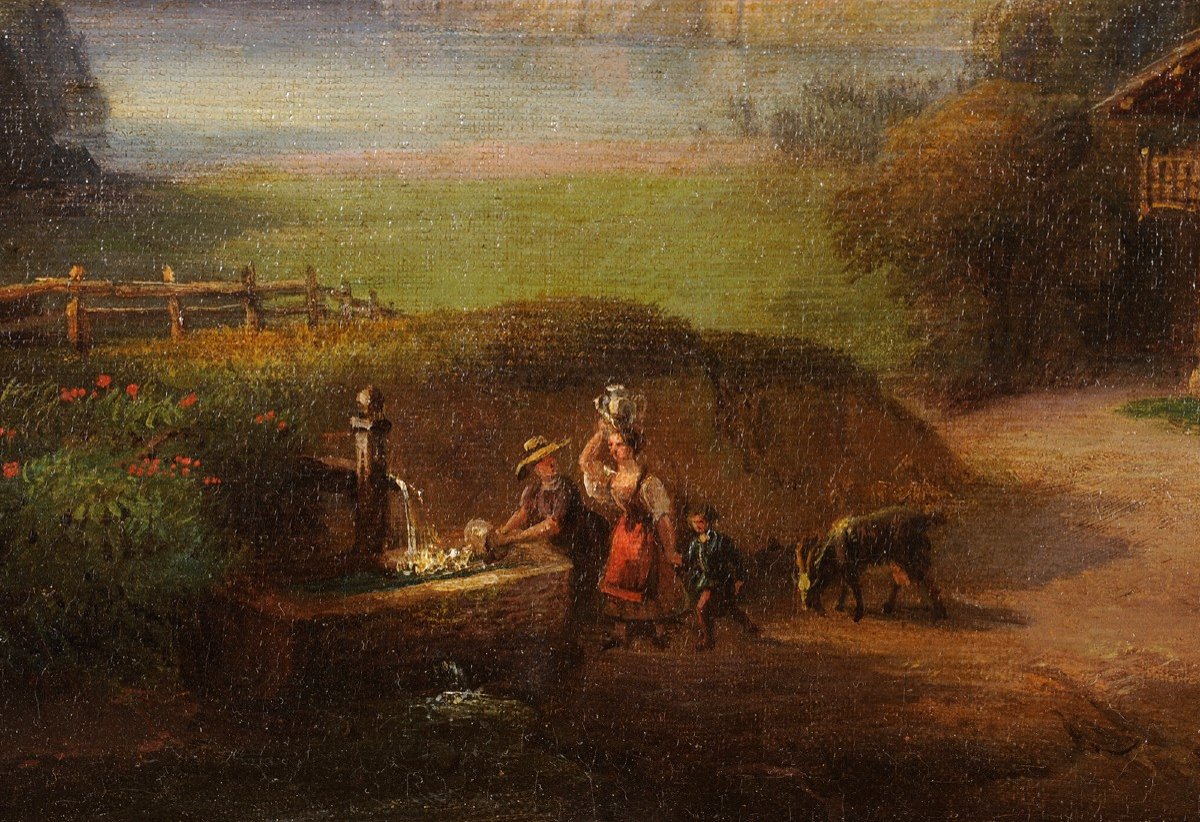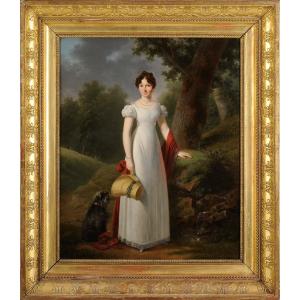(Courtalain, 1795 – Mareil-Marly, 1881)
Pilatus or Mount Pilate - Switzerland
Oil on canvas
H. 32 cm; L. 42 cm
Signed and dated lower right 1864
Exhibition, sales or collection label lower left “18”
François-Edme Ricois, although born in Courtalain in Eure et Loir, spent his entire childhood in Châteaudun where his parents ran a Rounnerie business. Following very basic studies at the town's elementary school, his family placed him around the age of thirteen in a notary's office. The experience is not a happy one: while copying his roles, the young clerk decides to illustrate them with flowers, animals and people. The notary considered that the drawing on stamped paper was a little expensive for him and with great regret, he returned the young Ricois to his parents. Fortunately, they had known the Duke of Montmorency, lord of Courtalain, for a long time, who took an interest in the young man and directed him to the workshop of a renowned artist close to him, the painter Gros. But the budding artist was more attracted to landscape than to history painting; also on March 2, 1816, he entered the École des Beaux-Arts and became a student of Girodet, Charles Bourgeois and especially Jean-Victor Bertin, himself a master of Corot, from whom he nourished himself with the principles of neo -classicism, and applied them throughout his life with intelligent flexibility in his views of town, port and castle which remain precise and poetic testimonies of the French province in the last century. To the advice of his masters, Ricois added personal outdoor work, traveling throughout France and even Switzerland. He debuted at the Salon in 1819 and participated throughout his life, his last submission dating from 1880, a few months before his death. He was rewarded with a second class medal in 1824. This success put him in vogue and from then on, he continued to take part in Parisian salons and various provincial exhibitions, notably in Douai, Lille, Toulouse and Cambrai, where he was again a medalist. He would undoubtedly have enjoyed the highest honors of his career if a cruel bereavement, the death of his young wife, Marie Constance Denin, which occurred after four years of marriage, had not turned his life upside down. Having become neurasthenic, he settled in Nantes, founded a mixed workshop there, and trained numerous students for many years. But the demon of his freedom quickly took hold of him again, and from 1834 he devoted himself to the study of the castles of the Loire. Constantly traveling to the four corners of France, the painter left a considerable documentary work of which it would be difficult to establish a catalog; locally, he reproduced the main castles of Eure-et-Loir: Châteaudun, Courtalain, Maintenon, Montigny-le-Gannelon, with a predilection for sites in the south of the department. His technique is diverse: the landscapes are treated with oil, watercolor, wash, and he also devotes himself to fixing on glass, a process popular in the 19th century. It was in Mareil-Marly, near Saint-Germain-en-Laye where he had acquired a property, that Ricois spent the last part of his life. The surroundings of Saint-Germain also provided him with material for a very large number of paintings. But repeating himself, the artist soon lost his originality and his charm... Reaching an advanced age, at 77, he nevertheless still obtained bronze medals at the international exhibition in London in 1875. This was the last burst of its flame. He lived for a few more years, but his weakened eyesight forced him to abandon the last sketches he was still making. From their union a daughter was born on December 2, 1830 named Marie-Octavie Ricois who was herself a painter and drawing teacher.
About Mount Pilatus: Its original name “Frakmünt” (the broken mountain) is simply explained by its appearance at the broken summit. If today and for many centuries it bears the name Pilate in reference to the famous governor of Judea, Pontius Pilate. According to legend, his body and soul rested at the bottom of a lake located at the summit, which caused the mountain to be cursed to the point of prohibiting its ascent. This restriction was explained because of violent storms which were unleashed on the nearby town of Lucerne, these would have been triggered by the man who ordered the execution of Christ, awakened by the intruders climbing the Alpine rock. Prison or even the death penalty were at stake for the recalcitrant. This ban was lifted at the end of the 16th century. Located in the heart of Switzerland, Pilatus overlooks the magnificent Lake Lucerne and the nearby city of Lucerne.



































 Le Magazine de PROANTIC
Le Magazine de PROANTIC TRÉSORS Magazine
TRÉSORS Magazine Rivista Artiquariato
Rivista Artiquariato